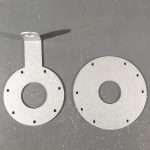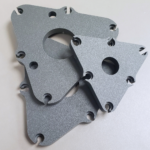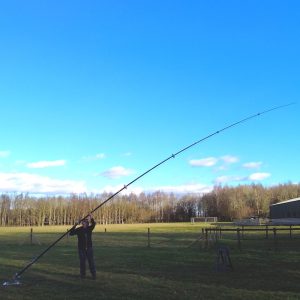
We have shipped more than 5,000 kits across the globe. Early kits were driven by cost and the components were often sourced based on price. Over the years, we have noticed it’s better to source the absolute BEST rather than the cheapest. High quality components are reflected in the price.
Alloy plates: These are cut in aircraft-quality 5251 alloy by a laser in England. These are then shipped to another company for deburring. Essentially, they are tumbled in a huge machine overnight to give us that “hammered” look which eliminates sharp edges and gives us a lovely finish.
Spreader Plates: We have used a lot of different plastics over the years including a natural colour Ultra High Molecular Weight Polyethelene which we had cut on a water-jet machine That material has the potential to eventually crack after about 3-years in high UV environments. We have now moved to a marine-grade high-density polyethylene sheet material which is sourced in USA. This is environmentally stabilized to withstand the harshest of marine conditions and is UV stable. This is not cut by water-jet anymore but machine cut, in England to our specifications.

Stay-Up Kit: Again, we have tried many different techniques to keep telescopic poles upright for years – including the tried and trust stainless hose clamp with maring tubing as a protective layer – which incidentally works very well – unfortunately, even stainless steel has it’s limits. It corrodes and can rust. After a 12-month testing regime, we moved to HCL’s EzyClamp system.
Shock-Cord: You would think something as mundane as a piece of shock-cord would be easy to source and use for long periods of time. Unfortunately, most shock-cord is not marine-proof for extended periods of time whilst under tension and not suitable for long-term outside use for ham radio. It stretches and becomes loose. After a long testing regime, we settled on a marine shock-cord, made in England with a Dyneema woven exterior from Marlow Ropes at much higher cost.
Fork Connectors. We are very keen to supply you with a larger fork connector rather than a small flimsy one. We normally supply a superior “chunky” fork connector which is a bit extreme for a single element but when under tension, the larger ones are much more superior to small ones.

Nuts, bolts and washers are also stainless steel. Again, sourced from a UK company.
SO239: Sourced from a UK company and made in brass and then nickel plated. The insert is PTFE, not a white plastic – and the threads are long enough for even longer PL259s that we now often enjoy to fit properly
Fiberglass Poles: It is unfortunate that the modern world is not interested in manufacturing telescopic fibreglass poles. These are the only components that come in from the Far East. DX Commander poles are made to our specification, spirally wound fibres and high quality epoxy and finished in paint. The quality is exceptional and we have a superb working relationship with the two factories (Classic and Signature series).
DX10 Wire: Made in England for DX Commander, DX10 has and outstanding reputation for both strength and in particular the extreme flexibility of the outer jacket. The jacket is “arctic grade” and is still flexible down to -40C/F. Originally designed for military use, the jacket is particularly strong but highly flexible, and the copper wire is made from 0.75mm2 (24/0.2mm) annealed copper.

Stickers: This might sound silly but even these exterior grade / UV stable and also made in the UK. Not just any stickers but DX Commander stickers!
We could probably source almost all these components from the Far-East at half the price – possibly even less – but the quality would suffer, the longevity would also be substantially reduced, and you would end up with a sub-standard antenna kit that would fall apart after 12-months.
Instead, we source the very best to give you years of exceptional performance backed-up up by our warranty and reputation.
The price of a DX Commander kit is therefore completely proportional to the quality.
Enjoy.
73. Callum, MoMCX
